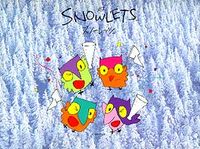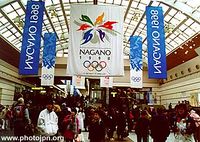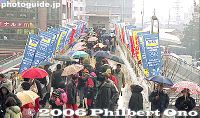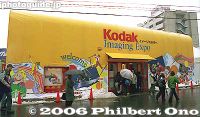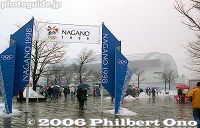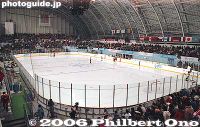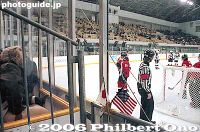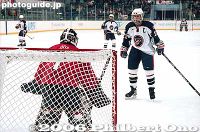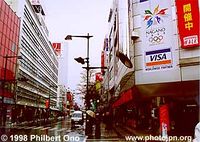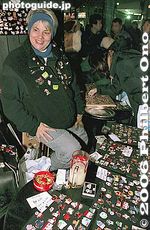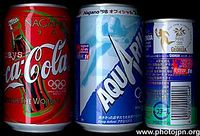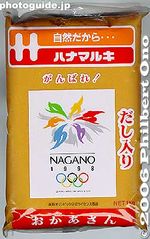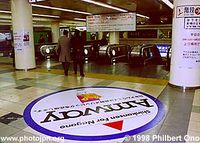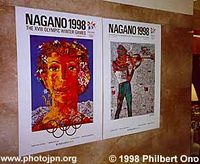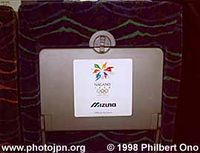Nagano Winter Olympics
by Philbert Ono
This article originally appeared in PhotoGuide Japan in Feb. 1998. It is reprinted here in 2006 since it is a Winter Olympics year when many of us in Japan will recall Nagano in 1998. You can see more photos are at our Nagano Winter Olympics photo gallery.
A Day at the Olympics
The Nagano Winter Games was just too close to pass up. The new Nagano Shinkansen bullet train made it only an 80-min. train ride from Tokyo. This was as close as I would get to any Olympics.
I have to confess that I was not at all enthused about the Nagano Games until about a week before it was to begin. It's funny how I (and the rest of Japan) suddenly became interested in the Games. On the day before the Winter Games commenced, I went to a Ticket Pia counter and looked through their list of Olympics events which still had seats. As expected, tickets for figure skating, ski jumping, and most men's ice hockey matches were all sold out. Then I saw that seats were available for many of the women's ice hockey games. There was the Japan vs. USA women's hockey match and I bought a ticket. I was going to my very first Olympics.
It was a day trip from Tokyo to Nagano on Feb. 12, 1998, the date of the hockey match. Even during my 11-hour stay in Nagano, I saw a lot. It was great. Of course, I never got to see Tara Lipinsky, Michelle Kwan, or Kazuyoshi Funaki, but I was able to get a good taste of the Olympics atmosphere. This Web page is my tribute to a successful Nagano Winter Games and my first Olympics. If you ever get a chance to go to an Olympics, you gotta see it at least once in your life.
Nagano city
Nagano Station
Obviously, Nagano Station was refurbished for the Olympics. It has become a beautiful place with sky light coming through the ceiling. As soon as you get out of the turnstile, you see people holding signs directing you to whatever venue you were going to. You either had to go a bus stop or another train platform. None of the venues were within walking distance from Nagano Station. However, the Olympic Plaza, Central Square (where they had the medal awards ceremony in the evenings), and Zenkoji Temple were all within walking distance.
Nagano Station Olympic Plaza
Adjacent to Nagano Station was the Olympic Plaza, an area featuring ten tent pavilions built by official sponsors. Each pavilion had various displays and activities promoting their products. The most popular pavilion was Snowlets House, the official store for Olympic souvenirs. There were a lot of ticket scalpers (all foreigners) hanging around the entrance. Inside, there was a ticket counter for events which still had seats.
Snowlets House was packed. There were four checkout lines and each one was about 30 meters long. The line went pretty fast though. They had all kinds of souvenirs: T-shirts, sweatshirts, flags, postcards, pins, key chains, necklaces, stuffed Snowlets, mugs, and even jewelry. I went on the 6th day of the Games and it still had everything well in stock. But I later heard that the shelves were laid bare well before the Games ended.
DID YOU KNOW THAT it's pronounced Na-GAH-no and not NA-ga-no nor Na'gno? Juan Samaranch got it right, but not Kevin Costner.
DID YOU KNOW THAT Eastman Kodak paid $44 million to the International Olympic Committee in 1995 to be the official film for the Nagano Games? It claimed that its film market share in Nagano right before the Games doubled to 20 percent, a claim doubted by Fuji Film.
Women's Ice Hockey
At Aqua Wing
USA vs. Japan (Feb. 12, 1998)
Nagano was the first Winter Olympics to feature women's ice hockey. Most of the women's ice hockey matches were held at a stadium called Aqua Wing which is actually an indoor swimming pool with a sliding roof. To get to this place, we had to take a local train from Nagano Station for a short ride to the next stop at Kita Nagano Station. This Kita Nagano Station was a tiny little train station certainly not meant for large crowds. It was unbelievably small. It took some minutes before we could get out of the station which was not much larger than a normal living room. The door was also small, enough for only two people to get out at one time.
Outside the station, we were directed to a bus stop where buses were shuttling to and from Aqua Wing. It was raining and miserable. The bus came soon and it was a short ride. However, the bus dropped us off far away from Aqua Wing. We had to walk another 12 minutes or so to get to Aqua Wing. Then we had to stand in line in the drenching rain to have our bags checked for security. Finally we could give our admission tickets to get in.
The place was quite full, and everyone was out to have a great time. There was excitement in the air. Japan was on a losing streak and the U.S. was undefeated. It was fun watching these girls play, slipping and sliding on the ice. Hockey is very fast-paced, more so than basketball. I liked it when the puck slammed into the glass (BOOM!) in front of me. The protective glass, by the way, must have been at least an inch thick. I was sitting almost right behind the goal.
It turned out that Japan was no match for the US. Team USA scored its first goal shortly after the game started. And whenever Japan got the puck, it was almost always stolen by the US. Japan hardly got a chance to even shoot for the goal. The US team's goal keeper must have been bored with nothing to do, while Japan's goal keeper was in a constant sweat. It was heartbreaking for the Japanese each time the US scored. Poor thing...
The final score was 10-0. Japan went on to lose all five of their matches and the US team went undefeated for the gold medal. The US and Canadian men's hockey teams were not the only ones who were put to shame at Nagano.
Japan's women's ice hockey team must feel pretty rotten about their pitiful playing on their home turf.
See more women's ice hockey photos at our Nagano Winter Olympics photo gallery.
DID YOU KNOW THAT a hockey puck weighs only about 160 grams but it can attain speeds in excess of 150 km/hr?
Commercial Olympics
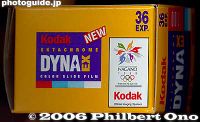
Billboard Buses
In Japan, they are called "wrap" buses because they are completely wrapped like a package. I hear it's all the rage in the U.S. The buses are not painted at all. The designs are decals stuck onto the buses. The decals can be readily peeled off to return the bus to its original appearance. These buses could be seen all over Nagano. For best design, IBM gets my vote. They had several different designs on their VIP buses. You can see here a speed skater and a bobsled team.
I was actually hired by the decal company (based in the US) to photograph the IBM buses being decaled. They flew in workers from the US to affix the decals on the buses in Tokyo. It took them about a week. The buses were hired from a major sightseeing bus company in Tokyo.
The decals covering the window portion of the bus have little holes in them so from the inside of the bus, the decals look transparent. IBM's Olympic pins and jacket were also based on these bus decal designs (see Olympic Souvenirs).
DID YOU KNOW THAT a beer company (Kirin Brewery) was an official sponsor of the Nagano Olympics? Can anybody tell me why beer is good for the Olympics? Does it enhance performance? Does drinking set a good example for youth? When Tae Satoya drank from a champagne bottle a friend stuck in her face right after winning the gold medal for moguls, Japanese officials got really nervous because they thought the alcohol may show up in the routine drug testing of medalists.
On the Street
Olympics-related advertising was most concentrated along the main drag from Nagano Station to Zenkoji Temple. I'm not against the commercialization of the Olympics. But I'm glad that the IOC was wise enough to ban blatant advertising within the venues. There are no rinkside ads at the hockey and figure skating arenas. But you see it everywhere else. I read in the papers that oyaki, a pumpkin-filled bun which is one of Nagano's delights, was going to be banned because it was not made by the official baker, Yamazaki Baking. That was taking things a little too far. Fortunately, we were able to eat those delicious oyaki in Nagano, even at the Aqua Wing concession.
DID YOU KNOW THAT Japanese private TV stations employed a former pro tennis player (Shuzo Matsuoka), a former female volleyball player (Motoko Ohbayashi), a former pro baseball player (Kazushige Nagashima), a former Olympic synchronized swimmer (Mikako Kotani), and a few teen idols to report on the Nagano Winter Games? Was my intelligence insulted or what? Fortunately, I watched most of the Games on NHK's satellite TV channel which used professional announcers.
And then, writers who had any kind of column (unrelated to any winter sports) in Japan's English newspapers (like The Japan Times) just had to write about the Nagano Games. There were the typical complaints, and there were the summaries of "What I thought was the best or worst." Since I don't have a newspaper column, I'm using my Web site to throw in my own 2 cents. (If you can't beat'em, join'em.)
Olympics Souvenirs
This little space (operated by official sponsor Mizuno) in the Yaesu underground mall at Tokyo Station used to have shelves full of Olympic souvenirs. On the day before the Olympics, I saw that they were selling towels, T-shirts, sweatshirts, jackets, mugs, postcards, Snowlets, key chains, and other things. I visited this place again on the last day of the Olympics (when I took this photo) and found a sign saying that they had sold out of Olympics souvenirs. According to the clerk, most were sold out about a week before.They only had a single rack selling expensive framed Olympic prints. The story was the same for the Snowlets House in Nagano and the Tokyo Branch at Mitsukoshi Dept. Store in Nihonbashi. I'm glad I bought my souvenirs early on.
DID YOU KNOW THAT there were 187 officially licensed pins for the Nagano Games?
Official Products
One of the benefits of being an official sponsor of the Olympics is that you get to splash the Olympics logo on your products. There are three categories of corporate sponsors of the Olympics. There are the TOP Partners, the Gold Sponsors, and the Official Suppliers and Supporters. TOP ("The Olympic Program") Partners are the highest-level sponsors who support the Games during the four years leading up to it. They are involved in the international marketing of the Olympic movement, which means they can display the Olympics logo on their products sold internationally. For Nagano, TOP Partners included Coca-Cola, IBM, Eastman Kodak, VISA, McDonald's, and UPS.
Gold Sponsors are companies who support only the Games itself. They can use the Olympics logo on their products only within the host country. For Nagano, Gold Sponsors included Mizuno (sports equipment and sports wear), Seiko (timer), Kirin Brewery (alcoholic beverages), and Amway Japan.
Official Suppliers and Supporters are also limited to the host country. They can use the Olympics logo on their products only within the host country. However, their rights are more limited than the Gold Sponsors'. For Nagano, such companies included Yamazaki Baking, Pia (ticketing), Brother Industries (sewing machines), Bridgestone, Japan Airlines, and Hanamaruki Foods (miso).
DID YOU KNOW THAT the International Olympic Committee considers coffee to be a performance-enhancing substance? Yep, it's a banned drug and Olympic athletes cannot drink coffee during competitions unless they want to be disqualified. So why did Coca-Cola advertise their Georgia coffee at Nagano? Coffee is officially banned but not marijuana. Bottled and canned Coca-Cola also contains caffeine, so are they banned too? If so, why is Coca-Cola an official sponsor? Is drinking coffee a good example for youth?
It's like my question about the official beer. Is drinking beer a good example for youth? It sure looks like it when you have an official beer. In Japan, a number of famous Olympic athletes have already appeared in beer commercials (and they all failed to reap a gold medal due to the so-called Kirin jinx). Yes, the Olympics (and Japan) have many ironies. Well, at least we don't have an official cigarette. (Oops, I hope that doesn't give anyone any ideas!)
Tokyo Station
Tokyo Station, the terminal for the Nagano Shinkansen bullet train going to Nagano, wouldn't let anyone at the station forget that there was an Olympics in Nagano.
Mizuno, an official sponsor, set up a nice Olympics exhibition in the Yaesu underground mall at Tokyo Station. There was a nice photo exhibit of past and current Winter Games and a souvenir shop as well. Our photo gallery shows part of Mizuno's exhibition.
Nagano Shinkansen
The Nagano Shinkansen (bullet train) is just as comfortable as any other high-speed train. It's a pleasant ride from Tokyo.
At Nagano Station, you are greeted in English, Japanese, and French.
For those of you who live in or near Tokyo and did not bother to see the Olympics, you really missed out. But even so, I hope this article gave you an idea of what it was like, especially outside the competition venues.
Although there were problems with the weather and accessibility of venues, it has been the most successful Winter Games for Japan. It won more medals than ever before, including its first Winter Games gold medal won by a woman (Tae Satoya in moguls). I guess having the home crowd does provide an advantage. These Games, even though I went for only a day trip, have been very memorable for me. Arigato Nagano, arigato Nippon!
DID YOU KNOW THAT when the Nagano Shinkansen reaches a terminal station (Tokyo and Nagano), the seats can turn around by itself? One thing less to do by the train's cleaning ladies.
DID YOU KNOW THAT "konnichiwa" was the only Japanese word 15-year-old, gold medalist Tara Lipinsky learned in Japan?
DID YOU KNOW THAT Asahikawa, a city in Hokkaido, also bid to be Japan's candidate city for the 1998 Winter Olympics? It spent quite a bit of money to promote itself, but in vain. Their failure is understandable since a Winter Olympics had already been held in Hokkaido at Sapporo in 1972.
See more photos at our Nagano Winter Olympics photo gallery.
